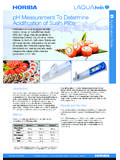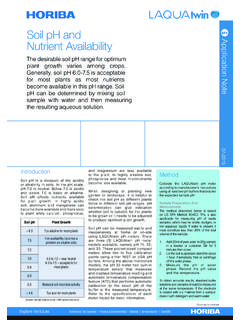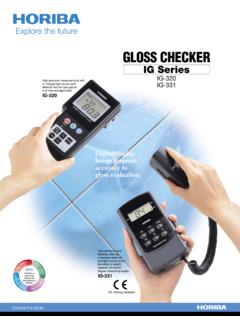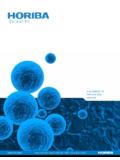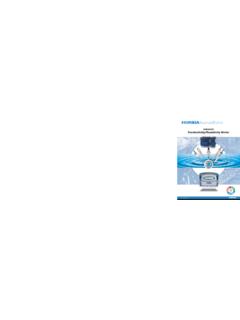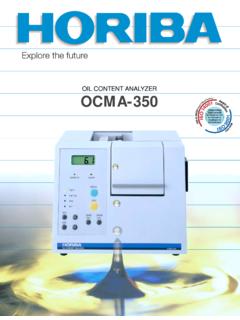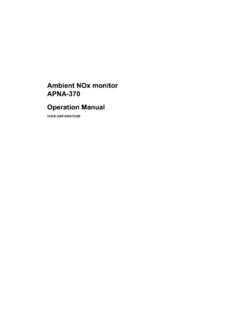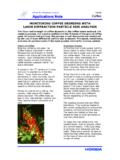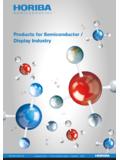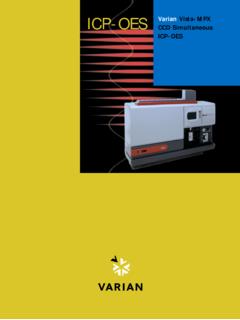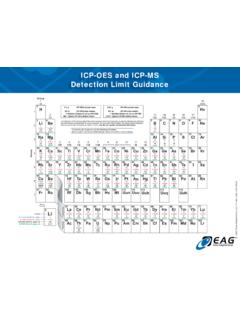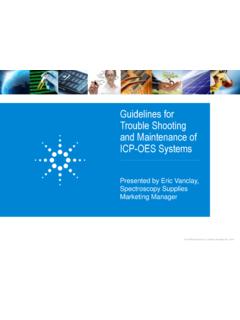Transcription of ICP OPTICAL EMISSION SPECTROSCOPY …
1 ICP-OES, ICP-MS and AAS Techniques ComparedGeoff TylerJobin Yvon , Horiba GroupLongjumeau, FranceKeywords: atomic SPECTROSCOPY , detection limit, linear dynamic range, interferences, precision, costof ownership, sample throughput1 IntroductionInductively coupled plasma- OPTICAL emissionspectrometry (ICP-OES) is an attractive tech-nique that has led many analysts to ask whetherit is wiser to buy an ICP-OES or to stay with theirtrusted atomic absorption technique (AAS) (1).More recently, a new and more expensive tech-nique, inductively coupled plasma-mass spec-trometry (ICP-MS), has been introduced as a rou-tine tool (2).ICP-MS offers initially, albeit at higher cost, theadvantages of ICP-OES and the detection limitadvantages of graphite furnace-atomic absorp-tion spectrometry (GF-AAS).
2 Unlike the famousprediction by Fassel, "..that AAS would be deadby year ", low cost flame AAS willalways have a future for the small lab with sim-ple article will briefly describe these three tech-niques, and point out the important criteria bywhich to judge their applicability to your ownanalytical problems. Table 1 below shows achecklist of common analytical requirements andmay help in the assessment of the many people with an ICP-OES background,ICP-MS is a plasma with a mass spectrometer asa detector. Mass spectroscopists would prefer todescribe ICP-MS as mass spectrometry with aplasma source. Either way, the technique is capa-ble of giving isotope information.
3 This informa-tion can help to overcome many of the "spectral"interference problems that can occur in the massspectrometer. Basically, the sample introduction system andplasma of ICP-OES and ICP-MS look similar. InICP-OES, the OPTICAL spectrum with a typicalrange of 165-800nm is viewed and measured,either sequentially or simultaneously. The simul-taneous ICP-OES can be faster for a large num-bers of elements, but more expensive, thansequential ICP-OES. This greatly depends on thenumber of elements, and the concentrationsrequired. More recently several ICP-OES spec-trometers are able to reach to 120 nm (3), thusenabling the determination of Cl at the primarywavelength of nm with sub-ppm detec-tion extracts the ions produced in the plasmainto an interface consisting of a sampler cone folICP OPTICAL EMISSION SPECTROSCOPYTECHNICAL NOTE 05 Table 1: Checklist of analytical many samples/week?
4 2. What are the sample types? (Steels, rocks, effluents, soils, etc)3. What method of dissolution may be employed? many and what elements need to be determined?5. Is Chlorine important (far UV option for someICP-OES spectrometers)? are the concentration ranges?7. What sample volume is typically available?8. What other options/accessories are being considered? Why?9. How important is isotope information to you?10. How much money is available to purchase or lease?11. What is the cost of ownership and running costs for the techniques to fulfill the requirements?12. What level of skill operator is available to you?2 ICP OPTICAL EMISSION SPECTROSCOPYTECHNICAL NOTE 05lowed by a skimmer cone.
5 This configurationenables the pressure to be reduced differentiallyfrom atmospheric pressure down to a final pressureof between 10-5to 10-7 Torr. The ions, once throughthe interface, are passed through ion optics, whichoptimize the ion paths to eliminate neutral speciesand light, usually by a photon stop. The ions thenpass through a mass filter, usually a quadrupole,before the selected ions reach the ICP-MS provides information for each atomicmass unit (amu), or Dalton. The ratio of the massof the ion to its charge, is displayed, and labeled m/z, in the mass region 3-250 Dalton. The isotopeinformation can be used in several ways; theseinclude isotope ratio measurements, often used forPb and U that do not have a constant natural abun-dance, and analysis of samples having unnaturalisotope dilution is a method of spiking the sampleswith a known concentration of a pure isotope toobtain a very accurate determination of the con-centration of the element.
6 A prerequisite of thistechnique is that the element of interest must havemore than one 1: Typical quadrupole ICP-MSFigure 2: Typical sequential (monochromator) ICP-OES3 ICP OPTICAL EMISSION SPECTROSCOPYTECHNICAL NOTE 052 Detection limits ICP-MS detection limits are very impressive (Table3, page 10). Most detection limits are in the 1-10part per trillion (ppt) range for solutions. These areas good as, or better than, GF-AAS for most ele-ments in pure water and also cover many more ele-ments. ICP-OES has typically two to three orders ofmagnitude poorer detection limits than ICP-MS,with most elements in the 1-10 part per billion (ppb)range.
7 Recently, one ICP-OES spectrometer (11) hasshown impressive detection limits in the sub-ppbregion for some elements using a high-resolutionmonochromator with a radially viewed spectrometers have been able to get improve-ments using an axially viewed ICP, although thisview has problematic matrix should be noted, however, that the commentabove about ICP-MS detection limits is for simplesolutions having low levels of other dissolved mate-rial. For detection limits related to concentrations inthe solid, the advantage for ICP-MS can be degrad-ed by up to 50 times because of the poorer dis-solved solids capability.
8 Some common lighter ele-ments ( , S, Ca, Fe, K and Se) have serious inter-ferences in ICP-MS, which degrade the detectionlimits far UV capability of some ICP-OES spectrometers has opened up some new applications, notably Cl in oils. Modern ICP-MS spectrometers have noweliminated negative ion capability to reduce the costof manufacture. This has left these ICP-OES spec-trometers as the only atomic SPECTROSCOPY methodfor the determination of Cl, Br, and AAS has generally poorer detection limitsthan ICP-OES except for the alkalis metals, , Na, Types of interferencesThe three techniques exhibit different types andcomplexity of interference problems.
9 For this rea-son, we will look at each technique ICP-MS SpectralThe spectral interferences in ICP-MS are predictableand number less than 300. Polyatomic and isobaricinterferences are found where a species has a sim-ilar mass to the analyte, whereby the resolution ofthe spectrometer (generally around Dalton) willnot resolve it, 58Ni on 58Fe, 40Ar on 40Ca,Figure 3: Typical double beam AAS4 ICP OPTICAL EMISSION SPECTROSCOPYTECHNICAL NOTE 0540Ar16O on56Fe, or 40Ar-40Ar on equations (similar in principle to inter-ele-ment correction in ICP-OES) can be used. In manycases alternative isotopes with lower natural abun-dances may be employed.
10 The use of mixed gases(small percentages of other gases such as nitrogenor ammonia added to the main argon gas) cansometimes be effective in reducing recently collision cell technology has offeredthe ICP-MS spectroscopists the opportunity tomeasure low concentrations using these optimalmasses. However, comments within the industrystill pose caution on its applicability with routineanalysis. Optimal gas choice is still problematicespecially for a routine busy background in ICP-MS is so low, typically <10counts/second, that it doesn't pose a problem. Thisis a major reason for the superior detection limits Matrix acidsIt should be especially noted that HCl, HClO4,H3PO4and H2SO4may cause considerable spectralproblems.
